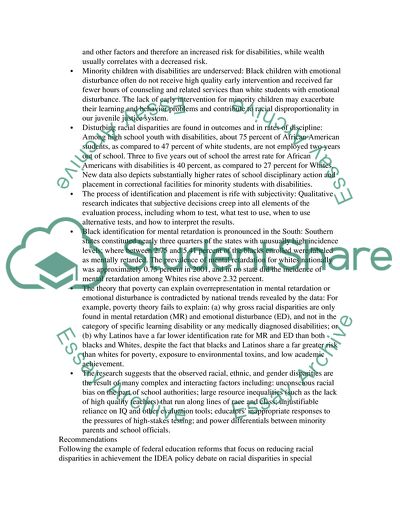
- Home
- Free Samples
- Premium Essays
- Editing Services
- Extra Tools
- Essay Writing Help
- About Us
- Studentshare
- Subjects
- Miscellaneous
- Policy Memo
Policy Memo - Essay Example

- Subject: Miscellaneous
- Type: Essay
- Level: Ph.D.
- Pages: 4 (1000 words)
- Downloads: 0
- Author: istoltenberg
Extract of sample "Policy Memo"
In 1998, approximately 1.5 million minority children were identified as having mental retardation, emotional disturbance, or a specific learning disability. More than 876,000 of these were black or Native American. Minority students, specifically black and Native American students, are significantly more likely than white students to be identified as having a disability. For example, in most states, African American children are identified at one and a half to four times the rate of white children in the disability categories of mental retardation and emotional disturbance.
In the national data, Latino and Asian American children are under identified in cognitive disability categories compared to whites, raising questions about whether the special education needs of these children are being met. However, school and district data showing instances of Latino overrepresentation suggest that there are both over and under representation concerns for these minority groups. Once identified, most minority students are significantly more likely to be removed from the general education program and be educated in a more restrictive environment.
For instance, African American and Latino students are about twice as likely as white students to be educated in a restrictive, substantially separate educational setting. Given that students with special needs benefit most when they are educated in the least restrictive environment to the maximum extent appropriate, the data on educational settings raise serious questions about the quality of special education provided to Latino, black, and other minority students compared to whites. The concern about racial inequity in special education is really part of a much larger concern about inequity in education generally.
We know that most children are deemed eligible for special education only after their general education teachers refer them for evaluation. Because general and special education are linked, our research and
...Download file to see next pages Read MoreCHECK THESE SAMPLES OF Policy Memo
Policy Memo - Renewable: Power Sector Restucturing
Policy memo- armed forces
Forward Style Inc. Employee Policy Memo
Policy Memo - Human Rights
Policy Memo; No Child Left Behind Act
POLICY MEMO PAPER ON DOMESTIC POVERTY
Policy memo vaccine about hepatitis B virus nyc
Policy Memo Analysis

- TERMS & CONDITIONS
- PRIVACY POLICY
- COOKIES POLICY